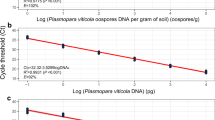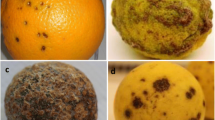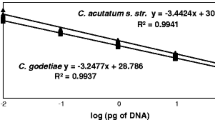Abstract
Colletotrichum abscissum and C. gloeosporioides are the causal agents of citrus Postbloom Fruit Drop (PFD), a major disease in several countries of the American continent. These pathogens infect only floral structures; however, in the absence of floral tissue, they survive asymptomatically on the leaf tissue. Thus, detecting and quantifying pathogens on leaves are critical for epidemiological studies. Colletotrichum species are detected through isolation, serological methods and conventional PCR, but these techniques are not effective for accurate detection of PFD agents. This study aimed to develop specific, more sensitive, faster and less laborious techniques than the traditional ones routinely used. We developed, standardized and validated a multiplex real-time PCR with high sensitivity (98–99.3%) and specificity (94.3–97.1%) for the detection and quantification of both pathogens. This technique was 1000 and 10,000 times more sensitive than Nested-PCR and PCR, respectively for the detection of C. abscissum. Similarly, the multiplex qPCR was 100 and 1000 times more sensitive than Nested-PCR and PCR, respectively for the detection of C. gloeosporioides. The diagnostic parameters used to validate the multiplex qPCR showed a high positive (17–35) and low negative (0.006–0.95) likelihood ratios, low percentage of false positives (2.8–5.6%) and false negatives (0.6–1.9%), good agreement between the results generated between qPCR and multiplex qPCR, revealed by the Kappa index (0.91–0.98) and coincidental results (95–99%). All parameters indicated that the multiplex qPCR was effectively validated to detect and quantify the causal agents of PFD.

Similar content being viewed by others
References
Agostini, J. P., & Timmer, L. W. (1994). Population dynamics and survival of strains of Colletotrichum gloeosporioides on citrus in Florida. Phytopathology, 84(4), 420–425.
Atallah, Z. K., Bae, J., Jansky, S. H., Rouse, D. I., & Stevenson, W. R. (2007). Multiplex real-time quantitative PCR to detect and quantify Verticillium dahliae colonization in potato lines that differ in response to Verticillium wilt. Phytopathology, 97(7), 865–872.
Brown, A. E., Sreenivasaprasad, S., & Timmer, L. W. (1996). Molecular characterization of slow-growing orange and key lime anthracnose strains of Colletotrichum from citrus as C. acutatum. Phytopathology, 86(5), 523–527.
Capote, N., Bertolini, E., Olmos, A., Vidal, E., Martínez, M. C., & Cambra, M. (2009). Direct sample preparation methods for the detection of Plum pox vírus by real-time RT-PCR. International Microbiology, 12(1), 1–6.
Cohen, J. (1960). A coefficient of agreement for nominal scales. Educational and Psychological Measurement, 20(1), 37–46.
Cullen, D. W., Lees, A. K., Toth, I. K., & Duncan, J. M. (2002). Detection of Colletotrichum coccodes from soil and potato tubers by conventional and quantitative real-time PCR. Plant Pathology, 51(3), 281–292.
Debode, J., Van-Hemelrijck, W., Baeyen, S., Creemers, P., Heungens, K., & Maes, M. (2009). Quantitative detection and monitoring of Colletotrichum acutatum in strawberry leaves using real-time PCR. Plant Pathology, 58(3), 504–514.
Denham, T. G. (1979). Citrus production and premature fruit drop disease in Belize. Pans, 25, 30–36.
Doyle, J. J., & Doyle, J. L. (1990). Isolation of plant DNA from fresh tissue. Focus, 12(1), 13–15.
Elnifro, E. M., Ashshi, A. M., Cooper, R. J., & Klapper, P. E. (2000). Multiplex PCR: Optimization and application in diagnostic virology. Clinical Microbiology Reviews, 13(4), 559–570.
Fagan, H. J. (1979). Postbloom fruit drop, a new disease of citrus associated with a form of Colletotrichum gloeosporioides. Annals of Applied Biology, 91(1), 13–20.
Feichtenberger, E. (1991). Queda dos frutos jovens de citros, doença induzida por uma raça virulenta do fungo Colletotrichum gloeosporioides. Laranja, 12(2), 513–521.
Gachon, C., & Saindrenan, P. (2004). Real-time PCR monitoring of fungal development in Arabidopsis thaliana infected by Alternaria brassicicola and Botrytis cinerea. Plant Physiology and Biochemistry, 42(5), 367–371.
Garrido, C., Carbú, M., Fernández-Acero, F. J., Boonham, N., Colyer, A., Cantoral, J. M., & Budge, G. (2009). Development of protocols for detection of Colletotrichum acutatum and monitoring of strawberry anthracnose using real-time PCR. Plant Pathology, 58(1), 43–51.
Klein, D., Bugl, B., Günzburg, W. H., & Salmons, B. (2000). Accurate estimation of transduction efficiency necessitates a multiplex real-time PCR. Gene Therapy, 7(6), 458–463.
Lima, W. G., Spósito, M. B., Amorim, L., Gonçalves, F. P., & Melo-de-Filho, P. A. (2011). Colletotrichum gloeosporioides, a new causal agent of citrus post-bloom fruit drop. European Journal of Plant Pathology, 131(1), 157–165.
Lin, Y., Stover, E., Sonoda, R., & Rosskopf, E. (2001). Stigma and style necrosis is associated with postbloom fruit drop disease in citrus following artificial inoculation. HortScience, 36(6), 1138.
Ma, Z., & Michailides, T. J. (2007). Approaches for eliminating PCR inhibitors and designing PCR primers for the detection of phytopathogenic fungi. Crop Protection, 26(2), 145–161.
Maclure, M., & Willett, W. C. (1987). Misinterpretation and misuse of the kappa statistics. American Journal of Epidemiology, 126(2), 161–169.
McCartney, H. A., Foster, S. J., Fraaije, B. A., & Ward, E. (2003). Molecular diagnostics for fungal plant pathogens. Pest Management Science, 59(2), 129–142.
McGovern, R. J., Seijo, T. E., Hendricks, K., & Roberts, P. D. (2012). New report of Colletotrichum gloeosporioides causing postbloom fruit drop on citrus in Bermuda. Canadian Journal of Plant Pathology, 34(2), 187–194.
Mills, P. R., Sreenivasaprasad, S., & Brown, A. E. (1992). Detection and differentiation of Colletotrichum gloeosporioides isolates using PCR. FEMS Microbiology Letters, 98, 137–143.
Mumford, R., Boonham, N., Tomlinson, J., & Barker, I. (2006). Advances in molecular phytodiagnostics – New solutions for old problems. European Journal of Plant Pathology, 116(1), 1–19.
Pinho, D. B., Lopes, U. P., Pereira, O. L., Silveira, A. L., & de Goes, A. (2015). Colletotrichum abscissum Pinho & O.L. Pereira, sp. nov. Persoonia, 34, 236–237.
Samuelian, S. K., Greer, L. A., Savocchia, S., & Steel, C. C. (2011). Detection and monitoring of Greeneria uvicola and Colletotrichum acutatum development on grapevines by real-time PCR. Plant Disease, 95(3), 298–303.
Schrader, C., Schielke, A., Ellerbroek, L., & Johne, R. (2012). PCR inhibitors – Occurrence, properties and removal. Journal of Applied Microbiology, 113(5), 1014–1026.
Silva, A. O., Savi, D. C., Gomes, F. B., Gos, F. M. W. R., Silva, G. J., Jr., & Glienke, C. (2017). Identification of Colletotrichum species associated with postbloom fruit drop in Brazil through GAPDH sequencing analysis and multiplex PCR. European Journal of Plant Pathology, 147(4), 731–748.
Silva-Junior, G. J., Spósito, M. B., Marin, D. R., Ribeiro-Junior, P. J., & Amorim, L. (2014). Spatiotemporal characterization of citrus postbloom fruit drop in Brazil and its relationship to pathogen dispersal. Plant Pathology, 63(3), 519–529.
Smith, C. J., & Osborn, A. M. (2009). Advantages and limitations of quantitative PCR (Q-PCR)-based approaches in microbial ecology. FEMS Microbiology Ecology, 67(1), 6–20.
Sreenivasaprasad, S., Sharada, K., Brown, A. E., & Mills, P. R. (1996). PCR-based detection of Colletotrichum acutatum on strawberry. Plant Pathology, 45(4), 650–655.
Timmer, L. W., Agostini, J. P., Zitko, S. E., & Zulfiqar, M. (1994). Postbloom fruit drop of citrus, an increasingly prevalent disease of citrus in the Americas. Plant Disease, 78(4), 329–334.
Tooley, P. W., Martin, F. N., Carras, M. M., & Frederick, R. D. (2006). Real-time fluorescent polymerase chain reaction detection of Phytophthora ramorum and Phytophthora pseudosyringae using mitochondrial gene regions. Phytopathology, 96(4), 336–345.
Vidal, E., Yokomi, R. K., Moreno, A., Bertolini, E., & Cambra, M. (2012). Calculation of diagnostic parameters of advanced serological and molecular tissue-print methods for detection of Citrus tristeza virus: A model for other plant pathogens. Phytopathology, 102(1), 114–121.
Waculicz-Andrade, C. E., Savi, D. C., Bini, A. P., Adamoski, D., Goulin, E. H., Silva, G. J., Jr., Massola, N. S., Jr., Teresawa, L. G., Kava, V., & Glienke, C. (2017). Colletotrichum gloeosporioides sensu stricto: An endophytic species or citrus pathogen in Brazil? Australasian Plant Pathology, 46(2), 191–203.
Ward, E., Foster, S. J., Fraaije, B. A., & McCartney, H. A. (2004). Plant pathogen diagnostics: Immunological and nucleic acid-based approaches. Annals of Applied Biology, 145(1), 1–16.
White, T. J., Bruns, T., Lee, S., & Taylor, J. W. (1990). Amplification and direct sequencing of fungal ribosomal RNA genes for phylogenetics. In M. A. Innis, D. H. Gelfand, J. J. Sninsky, & T. J. White (Eds.), PCR protocols: A guide to methods and applications (pp. 315–322). New York: Academic Press.
Wittwer, C. T., Herrmann, M. G., Gundry, C. N., & Elenitoba-Johnson, K. S. (2001). Real-time multiplex PCR assays. Methods, 25(4), 430–442.
Acknowledgments
This research was supported by a grant from São Paulo Research Foundation (FAPESP 2011/11629-1), National Council for Scientific and Technological Development (CNPq-140227/2013-0) and Coordination for the Improvement of Higher Education Personnel (CAPES-9810-11-0). We thank Dr. Antonio Vicent Civera for allowing the use of the mycology laboratory Valencian Institute for Agricultural Research to conduct some experiments.
Author information
Authors and Affiliations
Corresponding author
Rights and permissions
About this article
Cite this article
Pereira, W.V., Bertolini, E., Cambra, M. et al. Multiplex real-time PCR for detection and quantification of Colletotrichum abscissum and C. gloeosporioides on Citrus leaves. Eur J Plant Pathol 155, 1047–1059 (2019). https://doi.org/10.1007/s10658-019-01831-x
Accepted:
Published:
Issue Date:
DOI: https://doi.org/10.1007/s10658-019-01831-x




